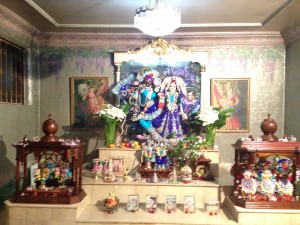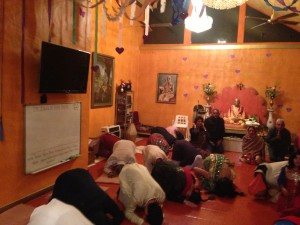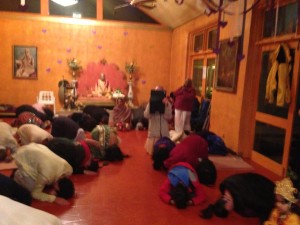madhava prabhu with bb govinda swami kirtan
madhava prabhu with bb govinda swami kirtan
The word ātmā
→ The Enquirer
It’s such an interesting Sanskrit word, ātmā, used in so many fascinating ways and worked into so many amazing compound phrases. Here’s one in particular that inspired this post as a part of the process of unraveling it.
ātmātmany ātmanātmānam
- SB 2.6.39
This compound phrase uses the word ātmā four times, with four different endings.
(1) ātmā (2) ātmani (3) ātmanā (4) ātmānam
The basic word, ātmā (or ātman), means “the individually distinct entity,” aka, the self.
Ātmani means, to/into the self.
Ātmanā means by the self.
Ātmānam is possessive, it means one’s own.
Therefore, this phrase, “ātmātmany ātmanātmānam” – spoken by Brahmā when describing the transcendental position of the Incarnations of the Supreme Being – means:
“His self is within himself, created by and composed of only himself”
This statement is raised in reference to the doubt that an incarnation of the Supreme might be a conditioned projection of the true identity of the supreme being. This establishes that the Supreme is never conditioned – wherever and whenever he manifests himself, he does so fully, purely, and without finitude or dichotomy to his original nature.
ISKCON Scarborough- Slideshow of pictures taken during Janmastami 2013
→ ISKCON Scarborough
ISKCON Scarborough- Bhagavad Gita 4.9- live radio program
→ ISKCON Scarborough
ISKCON Scarborough – Janmastami celebrations- 2013
→ ISKCON Scarborough
The weakness within
→ KKS Blog
(Kadamba Kanana Swami, 25 June 2013, Czech Summer Camp, Srimad Bhagavatam 8.3.1)
 Srila Bhaktivinode Thakur describes that in a situation of war, one is facing the army of the enemy and that we are not only facing the army of the enemy opposite us but the enemy has also sent spies into our own ranks. Srila Bhaktivinode Thakur explains that in the same way, in the war with maya, we are not just standing opposite of maya - it is not only that maya is outside of us presenting different temptations – but maya is also within, indriyāṇi mano buddhir asyādhiṣṭhānam ucyate (BG 3.40). It is said that lust is situated within in the senses, the mind and the intelligence. So in this way, there is weakness from within.
Srila Bhaktivinode Thakur describes that in a situation of war, one is facing the army of the enemy and that we are not only facing the army of the enemy opposite us but the enemy has also sent spies into our own ranks. Srila Bhaktivinode Thakur explains that in the same way, in the war with maya, we are not just standing opposite of maya - it is not only that maya is outside of us presenting different temptations – but maya is also within, indriyāṇi mano buddhir asyādhiṣṭhānam ucyate (BG 3.40). It is said that lust is situated within in the senses, the mind and the intelligence. So in this way, there is weakness from within.
Therefore we have to protect ourselves very carefully - both within and without. Internally, always cleansing our consciousness, ceto-darpana-mārjanam (CC Antya 20.12), by the process of hearing and chanting and externally by placing ourselves in a safe position.
The weakness within
→ KKS Blog
(Kadamba Kanana Swami, 25 June 2013, Czech Summer Camp, Srimad Bhagavatam 8.3.1)
 Srila Bhaktivinode Thakur describes that in a situation of war, one is facing the army of the enemy and that we are not only facing the army of the enemy opposite us but the enemy has also sent spies into our own ranks. Srila Bhaktivinode Thakur explains that in the same way, in the war with maya, we are not just standing opposite of maya - it is not only that maya is outside of us presenting different temptations – but maya is also within, indriyāṇi mano buddhir asyādhiṣṭhānam ucyate (BG 3.40). It is said that lust is situated within in the senses, the mind and the intelligence. So in this way, there is weakness from within.
Srila Bhaktivinode Thakur describes that in a situation of war, one is facing the army of the enemy and that we are not only facing the army of the enemy opposite us but the enemy has also sent spies into our own ranks. Srila Bhaktivinode Thakur explains that in the same way, in the war with maya, we are not just standing opposite of maya - it is not only that maya is outside of us presenting different temptations – but maya is also within, indriyāṇi mano buddhir asyādhiṣṭhānam ucyate (BG 3.40). It is said that lust is situated within in the senses, the mind and the intelligence. So in this way, there is weakness from within.
Therefore we have to protect ourselves very carefully - both within and without. Internally, always cleansing our consciousness, ceto-darpana-mārjanam (CC Antya 20.12), by the process of hearing and chanting and externally by placing ourselves in a safe position.
The weakness within
→ KKS Blog
(Kadamba Kanana Swami, 25 June 2013, Czech Summer Camp, Srimad Bhagavatam 8.3.1)
 Srila Bhaktivinode Thakur describes that in a situation of war, one is facing the army of the enemy and that we are not only facing the army of the enemy opposite us but the enemy has also sent spies into our own ranks. Srila Bhaktivinode Thakur explains that in the same way, in the war with maya, we are not just standing opposite of maya - it is not only that maya is outside of us presenting different temptations – but maya is also within, indriyāṇi mano buddhir asyādhiṣṭhānam ucyate (BG 3.40). It is said that lust is situated within in the senses, the mind and the intelligence. So in this way, there is weakness from within.
Srila Bhaktivinode Thakur describes that in a situation of war, one is facing the army of the enemy and that we are not only facing the army of the enemy opposite us but the enemy has also sent spies into our own ranks. Srila Bhaktivinode Thakur explains that in the same way, in the war with maya, we are not just standing opposite of maya - it is not only that maya is outside of us presenting different temptations – but maya is also within, indriyāṇi mano buddhir asyādhiṣṭhānam ucyate (BG 3.40). It is said that lust is situated within in the senses, the mind and the intelligence. So in this way, there is weakness from within.
Therefore we have to protect ourselves very carefully - both within and without. Internally, always cleansing our consciousness, ceto-darpana-mārjanam (CC Antya 20.12), by the process of hearing and chanting and externally by placing ourselves in a safe position.
SB 4.9.6 Sincerity attracts the Lord to manifest his presence within and without
→ The Spiritual Scientist
Attentive Japa Opens One’s Hear
→ Japa Group
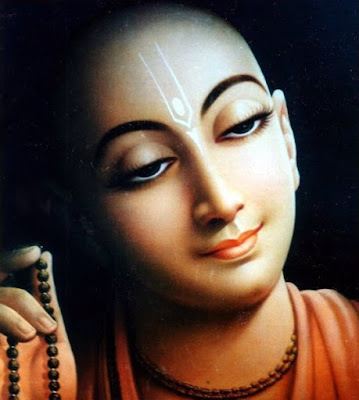
"Chanting attentive japa opens one's heart to higher and higher stages of loving God, just as natural forces make a lotus unfold or the moon seem to wax.
We japa chanters often begin a japa session dull, anxious, or bewildered. We leave it strong and focused. Why? Not because our breath becomes regulated or our minds numb; we change during japa because, however awkwardly, we are associating with Krsna by chanting His name."
From Japa And The Opening Heart
by Kalakantha dasa
BTG Magazine #42 2008
05.26 – The greatest danger is the danger of forgetting the danger
→ The Spiritual Scientist
During a war, a wily enemy often induces in a well-equipped opponent a false sense of victory – and then fells the unprepared opponent with a fast and furious blow. That’s why, in a war forgetting the danger can be the greatest danger.
When we practice spiritual life, we declare war against the immoral and anti-devotional desires that have held us hostage for many lifetimes. These desires have kept us deprived of the everlasting devotional joy that is our spiritual birthright as the beloved parts of the all-blissful Supreme Being, Krishna. Only by combating and conquering such hostile desires can we reclaim our right to real happiness.
In this inner war, the process of devotional service to Krishna provides us the firepower necessary for victory – it bestows a higher happiness that makes lower pleasures unappealing.
To counter our devotional advantage, the wily forces of illusion often deceive us into believing that we have already conquered our lower desires – and so we don’t need to remember Krishna carefully. And when we are off guard, those forces allure and ensnare us.
To protect us from this deception, the Bhagavad-gita (05.24) urges us to tolerate the urges of desire and anger till the moment we become liberated from the body (prak sharira vimokshanat), that is, lifelong for as many lifetimes as need to attain liberation. Lest this seem too demanding and discouraging a prospect, the Gita assures two verses later (05.26) that conscientious practitioners (vidita-atmanam) will attain final liberation in the very near future (abhito brahma-nirvanam).
The best way to be vigilant is not by focusing on the desires to be avoided but on the devotion to be cultivated. As devotional remembrance of Krishna brings the ultimate fulfillment, the mandate for vigilance makes us not paranoid, but satisfied – supremely satisfied.
**
05.24 - Those who are free from anger and all material desires, who are self-realized, self-disciplined and constantly endeavoring for perfection, are assured of liberation in the Supreme in the very near future.
Here is what people think about New Vrindaban!
→ New Vrindaban Brijabasi Spirit
Results of the WVU “Branding” Survey for New Vrindaban Aug. 2013
or What exactly is New Vrindaban’s image?
In many conversations and letters, Srila Prabhupada lovingly explained the different aspects of his dream for New Vrindaban. He told us that his vision was, of course, based first and foremost on developing our love for Krsna. Fixed on this solid foundation, he spoke of four other categories, one of which is New Vrindaban as a holy place of pilgrimage.
Following Prabhupada’s lead, we wanted to find the most efficient ways to present the community as a holy place of pilgrimage. New Vrindaban engaged some students and professors on the West Virgina University (Morgantown, WV) community design team for different projects during the master planning in 2012, one of which was this branding survey. Some pleasantly surprising results came out of their project.
The survey covered two main topics in detail, namely how the members of New Vrindaban see themselves, and how pilgrims and visitors see New Vrindaban.
The goal of the survey was to identify the main elements of the community brand and then to verify if the brand was consistent with both the community’s internal identity and the image from outsiders. It turned out that the three main structures in New Vrindaban found to be most important to both residents and guests are: Palace of Gold, the Temple, and the Deities (statues) in the temple.
The things that people valued most about New Vrindaban was that it was a very spiritual place, with a peaceful atmosphere amidst scenic beauty. Curiosity was another thing that makes people visit.
It was happily noted overall that the survey-takers found the devotees to be hospitable and that the devotion and the spiritual atmosphere are priorities in people’s eyes.
A vast majority of people heard about the community through word of mouth. It was very favorable to note that more than 80% of the pilgrims want to visit again, plus they want to recommend New Vrindaban to their friends.
There are certain challenges that the community could improve on, such as the sanitation of the facilities, road signage and directions.
Some words that people used to describe New Vrindaban are “spiritual”,” simple living”, “hospitable”, “peaceful”, and “beautiful”.
The survey was headed by Professor Kudzayi Maumbe, Ph.D., of the dept. of Recreation, Parks & Tourism Resources , WVU.
We learned from this branding survey that a popular opinion is that New Vrindaban is a peaceful and spiritual place of pilgrimage where plain living and high thinking are emphasized. The community will strive to strengthen the areas that need improvement.
HG Prema Caru Prabhu / SB 10.47.27
→ Kalachandji's Audio Archive
HG Deva Darsana Prabhu / SB10.47.22-23
→ Kalachandji's Audio Archive
HG Nityananda Chandra Prabhu / SB 10.47.12-21
→ Kalachandji's Audio Archive
HG Nityananda Prabhu / Sri Krsna Janmastami
→ Kalachandji's Audio Archive
the bhakti experiment
→ everyday gita
As someone who spent numerous years studying Science, the scientific method is ingrained in my head. You start off with an objective, follow it up with a hypothesis, design the tests and run the experiment, collect and analyze your observations and draw a conclusion.
You can imagine my surprise when I realized that the process of bhakti yoga is actually very scientific! Specifically, the teachings of the Gita. What may throw readers off, as I personally discovered, is the fact that sometimes the expected results are given before the objective is presented in said text. It's important to remember at such times, that this is due to the fact that Arjuna was already following the path of bhakti and that's why Krsna didn't need to get into all the details.
It's kind of like coming into a conversation when you haven't heard the beginning. You can get an idea and start to surmise what the gist of it is, but if you don't have someone walk you through the background, you'll never get the full picture. For anyone who has read the Gita on their own and tried to make sense of it, perhaps you are nodding your head in agreement.
Again, this only serves to reiterate the need for a teacher who has themselves been taught the Gita and is practically applying it in their own lives. In fact, as we will hear shortly, the need to evaluate a genuine bhakti teacher is done by observing their behavior and noting the results.
Here the conclusion obtained from performing the bhakti experiment of "working without being attached to the results" is given: one feels ever satisfied and independent. Independent from what? From the rolling waves of happiness and distress. One instead feels peaceful and calm.
Now for anyone who has worked in or run labs, you'll remember that you need to perform the experiment a minimum of three times and get the same result three times for it to be valid. From personal experience, I'll tell you - it's very rare to get the same result three times in a row! That's because the procedure needs to be followed exactly and the conditions have to be replicated perfectly. The same holds true for the bhakti experiment of working without attachment to the results.
If one doesn't follow the methods and conditions outlined in the Gita, then it is only natural that the result will not be the same. Practically this translates to: don't give up! If the experiment doesn't work for you, it could mean that something is off. Don't blame the method (as any lab researcher/scientist will tell you!), but go back and analyze what you did.
The outcomes from this bhakti experiment vary depending on what you put into it. So if you sincerely want to get the results outlined in the Gita, such as those of peace, satisfaction and happiness, you have to follow the method given accurately. Good luck and feel free to share what you come out with in the comments below!
Huge statue made from pure gold of the cosmic Vishnu was discovered in a temple in South India
→ Dandavats.com
 Garuda das: This absolutely beautiful large solid gold statue of the cosmic Vishnu was discovered in a temple in South India. Its sheer weight in gold is worth over a billion dollars, and furthermore, it is one of the most exquisite works of sculpture in the history of Indian art. Note the deity of creation, Brahmā, rising out of the navel of Vishnu on the blossom of a lotus flower! Read more ›
Garuda das: This absolutely beautiful large solid gold statue of the cosmic Vishnu was discovered in a temple in South India. Its sheer weight in gold is worth over a billion dollars, and furthermore, it is one of the most exquisite works of sculpture in the history of Indian art. Note the deity of creation, Brahmā, rising out of the navel of Vishnu on the blossom of a lotus flower! Read more › Janmastami Photos!
→ Mayapur.com
Please view the following galleries: Abhishek Samskaras Darshan Night Darshan Our temple room was packed with devotees that were anxious to see the abhishek of the Lord, and perform abhishek of there own. The day was filled with programs to engage the devotees in keeping their minds fixed upon the activities of Sri Sri Radha-Madhava. [...]
The post Janmastami Photos! appeared first on Mayapur.com.
60 High Resolution photos from beautiful Mayapur: Morning Samskaras
→ Dandavats.com
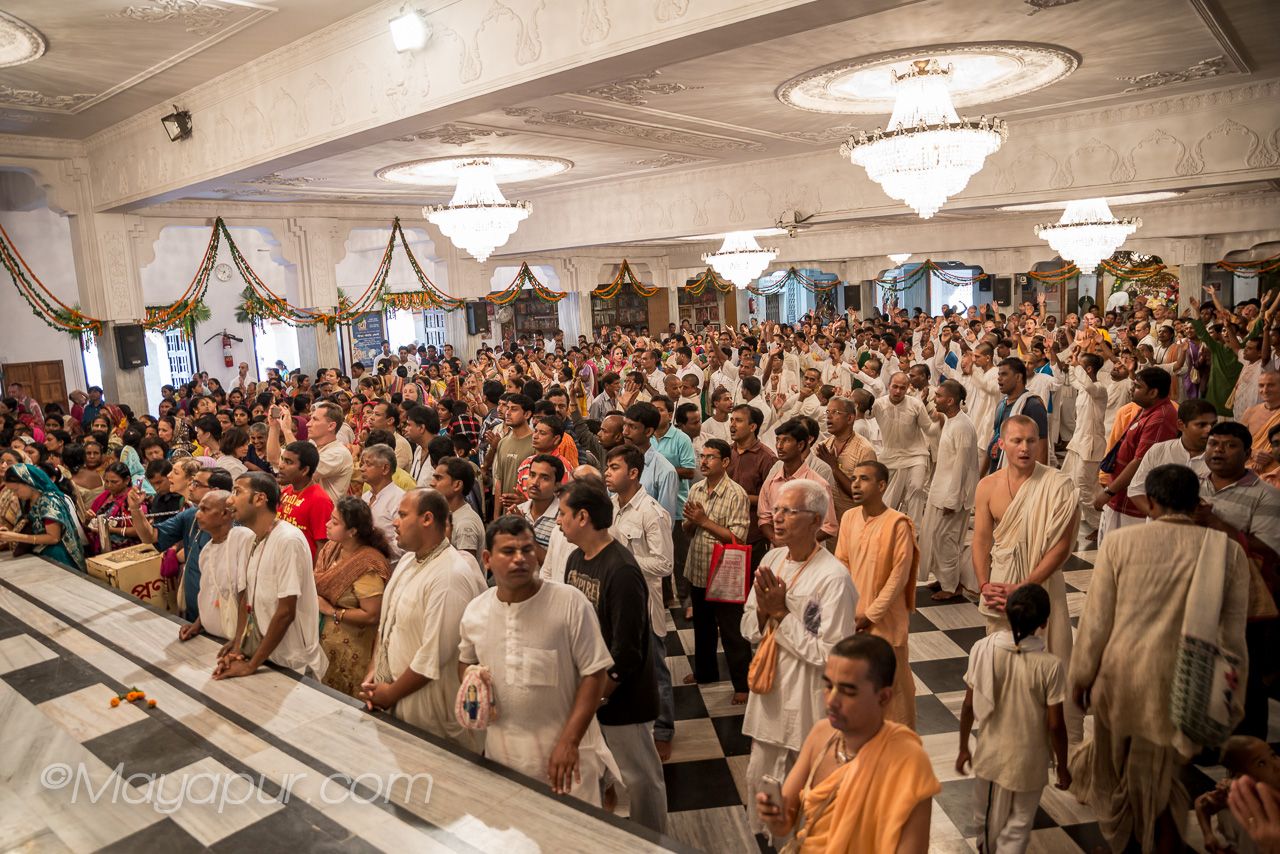 60 High Resolution photos from beautiful Mayapur: Morning Samskaras Read more ›
60 High Resolution photos from beautiful Mayapur: Morning Samskaras Read more › Jamnastami Morning Samskaras
→ Mayapur.com
The post Jamnastami Morning Samskaras appeared first on Mayapur.com.
Janmastami Abhishek Gallery
→ Mayapur.com
The post Janmastami Abhishek Gallery appeared first on Mayapur.com.
If you are interested in a 3+hr long kirtan with Sivarama and Sacinandana Swamis at Soho Temple, then here is one
→ SivaramaSwami.com
KC and World Religions (6)
→ The Spiritual Scientist
Six Opulences of Lord Chaitanya (6)
→ The Spiritual Scientist
Conversation
→ SivaramaSwami.com
The difference between an uttama-bhagavata and an uttama-adhikari and the sign of success in preaching.
7 min vid: Iskcon Brisbane Janmastami 2013 by Vraja Dhama Das
→ Dandavats.com
 7 min vid: Iskcon Brisbane Janmastami 2013 by Vraja Dhama Das Read more ›
7 min vid: Iskcon Brisbane Janmastami 2013 by Vraja Dhama Das Read more › 350 photos: Festival Nama-hatta 29.08.-1.09.2013 at New Santipur – Czarnów near Stone Mountain
→ Dandavats.com
 350 photos: Festival Nama-hatta 29.08.-1.09.2013 at New Santipur - Czarnów near Stone Mountain Read more ›
350 photos: Festival Nama-hatta 29.08.-1.09.2013 at New Santipur - Czarnów near Stone Mountain Read more › HH Radhanath Swami Dancing at Maha Kirtan Mela at Gita Nagari Retreat Aug 2013
→ Gouranga TV - The Hare Krishna video collection
HH Radhanath Swami Dancing at Maha Kirtan Mela at Gita Nagari Retreat Aug 2013
Radhakunda Seva’s August 2013 44 Photos and Updates
→ Dandavats.com
 Lalita Kunda took on a brand new appearance this month with new paint and décor. The plants in our gardens are flourishing in the monsoon rains. The paintings at Jihva Mandir are coming to life. Cleaning is continuing. Your servants, Mayapurcandra dasa and Campakalata devi dasi Read more ›
Lalita Kunda took on a brand new appearance this month with new paint and décor. The plants in our gardens are flourishing in the monsoon rains. The paintings at Jihva Mandir are coming to life. Cleaning is continuing. Your servants, Mayapurcandra dasa and Campakalata devi dasi Read more › Spectacular little picture book on Lord Krsna from the web
→ ISKCON Scarborough
Krishna’s Funskool Begins This Sunday!
→ The Toronto Hare Krishna Blog!
 Would you like to have your children learn Vedic culture in a fun-filled, hands-on atmosphere? If yes, then bring them to Krishna’s Funskool! The Hare Krishna Temple in Toronto has been offering Sunday classes for children ages 5-12 for several years. Lessons are based on the Bhagavad Gita, Upanishads, Srimad Bhagavatam and other Vedic literatures. The Sunday School program is designed to give the children a rich experience of the Vedic culture.
Would you like to have your children learn Vedic culture in a fun-filled, hands-on atmosphere? If yes, then bring them to Krishna’s Funskool! The Hare Krishna Temple in Toronto has been offering Sunday classes for children ages 5-12 for several years. Lessons are based on the Bhagavad Gita, Upanishads, Srimad Bhagavatam and other Vedic literatures. The Sunday School program is designed to give the children a rich experience of the Vedic culture. When does the new session begin?
What time?
Where?
In Govinda’s Dining Hall.
What classes are taught?
Children will learn a variety of spirtual topics, including “Devotional Practices,” “What Makes Someone God?” “The Material World and the Spiritual Sky,” “Who Am I?” “Bhagavad Gita,” “Vaishnava Behavior,” and “Animals in the Vedas,”to name a few.
Registration Information
• One Sunday School session lasts 2 months. There are 5 sessions per year.
• Registration fees are $15 per child per session, $10 for the second + child.
• No new registration is allowed in the middle of a session. Parents can enroll
their children for the following session.
We hope you will take advantage of this opportunity for your children to strengthen and reinforce their Vedic upbringing. The students develop positive, spiritual friendships with other children and learn how to make Krishna Consciousness part of their everyday life. For more information about registration or classes, please contact us at kids@torontokrishna.com.
ISKCON Scarborough- Janmastami slideshow- 2013
→ ISKCON Scarborough
ISKCON Scarborough – BG 4.9 – Live Bhagavad Gita Radio program – 31st Aug 2013
→ ISKCON Scarborough
Sunday, September 1st, 2013
→ The Walking Monk
Limerick, Saskatchewan
Just a short horse’s ride from where Chief Sitting Bull came to rest during his efforts to fight for his people, I had been walking. What an honour.
With the previous evening’s rain, and night time darkness, many salamanders came out of their areas to make a migration over the ruthless road. Blotches of their remains stain the highway. When I saw one fellow trying to make his way across, I felt I owed him one, given I had caused one of his maybe cousins to curl, squirm and squeal with my umbrella’s tip the other day. In my curiosity and exploration, I believe I gave him some pain.
“Let me treat this new guy nicely,” I thought. And then I remembered having a chat with a newspaper journalist who had come to interview me in 2007. He relayed how he was trying to do something “karmically safe” when in a grumpy mood he kicked severely a neighbours dog. He felt terribly guilty after that and decided to purchase a dog of the same breed and to look after him just to make amends.
With the same sentiment I thought I would approach the salamander and be nice to him. I stretched my body fully lying on the road (it was a quiet hour), I gave him a stroke on his head, then his back, tail and belly. He seemed to like it to the point where he remained stationary for the petting. He even closed his eyes. He then moved toward me to get more affection.
Because of this little exchange I was compelled to try it on two other guys. They reciprocated the same way. It looks like the non violent approach really works. I earned the title ‘Ghandi’ today from a motorist who shouted out the name even though he was unaware of what I had done previously.
In the afternoon it was in Regina at the ISKCON Center that I gave a talk from the Bhagavad Gita verse 5.20 which reads:
“A person who neither rejoices upon acheiveing something pleasant, nor laments upon obtaining something unpleasant, who is self intelligent, unbewildered, and he knows the science of the Absolute is to be understood to be already situated in transcendence.”
This is not to say that there are to be no feelings of compassion, but one must appreciate the neutral stance we benefit from in dealing with the dualities of this world.
I’d like to thank Justin Crann of the Moose Jaw Time Harold, who got us on the front page of the long weekend issue. In the picture I am portrayed chanting and playing on the dolak drum. The caption in bold reads, “On The Long Road To Enlightenment”. Thanks, Justin.
33 KM
Srila Prabhupada’s Vyasa-puja Celebration, August 29, ISKCON Silicon Valley, Mountain View, California
Giriraj Swami


—————————————————————————————–
“I think of the many gifts Srila Prabhupada gave us: the holy name, the Srimad-Bhagavatam and other scriptures, the temples and deities — but I am also thinking now of the association of devotees, especially close friends. The association of peers is so important. One devotee commented that when you are in a position of a superior you have to be on good behavior, to set a proper example and do the right things. And when you are with superiors, you also have to be on good behavior, because you are with a superior — you have to be at your best. So with whom can you actually reveal your mind — your doubts, your questions, your confusion, your misgivings, your weaknesses? There can be an element of friendship with superiors, but it is mainly with peers. And that friendship is most precious.” — Giriraj Swami
Offerings by devotees:
Mahaguna dasi
Akruranatha dasa
Kanka dasi
Trai dasa
Nirakula dasi
Rtadhvaja Swami
Jagarini dasi
Satyadeva dasa
Kesava Bharati Dasa Goswami
Bhumi dasi
Srila dasa
Giriraj Swami
Malini dasi
asking the tough question
→ everyday gita
Why is it so difficult to put things into practice? We may theoretically understand so many things and accept them on an intellectual level, but when it comes to the practical application, many of us face a block.
For those who are trying to live a life of simultaneous gratitude and unattachment, this is often a conundrum. When we read bhakti texts like the Gita and hear from those who live such lives, we feel inspired and hopeful. We too can do it! But when it comes to actually putting in all our endeavours and efforts and offering it selflessly to the Divine as a token of our appreciation, something powerful interrupts us. These things can cause us to promptly fall back into our old way of thinking and doing things which is often that of - I perform x activity and expect y result.
One such challenge can come in the form of doubt. When doubt steps in, it can cause us to question what will happen if we let go of our attachment to the results of our endeavour. "Maybe I'll become too spiritual! What if I just stop caring about everything? I want to be normal and if I start actually becoming unattached, I might not be able to relate to others." Such types of conversations can start to take place in our mind.
When these doubts start to cloud our consciousness, it's very easy to become apprehensive. It causes us to become fearful of the unknown - in this case what will happen to us if we actually live a life of gratitude and detachment. Ultimately, it can be a vicious cycle that leads to more doubts and more apprehension.
Ultimately though, the root cause of all these misgivings is fear. The fear that our efforts to express gratitude and appreciation will go unrecognized. Although we may believe in a Divine power and personality who is giving us everything, do we really and truly believe?
The practice of performing akarmic work is more than just attitude. It prompts us to ask the tough questions and really look inside our hearts. Do we have unshakable faith that there is something greater than us and that the Divine is there ready and waiting to reciprocate with us? When we are able to answer that question honestly, irregardless of whether it is a no, yes or somewhere in between, then we can truly start to live a life of gratitude and selflessness.
The Krishna consciousness movement is meant for global peace and happiness
→ The Spiritual Scientist
At the present moment practically the entire world is afraid of rogues and nondevotees; therefore this Kṛṣṇa consciousness movement is started to save the world from irreligious principles. Everyone should cooperate with this movement in order to bring about actual peace and happiness in the world.
Letter Of Appreciation
→ Japa Group

"This website has inspired such an old (55) aspiring devotee! I live 2 hours from the nearest temple so this keeps me intouch with the "work" of Krishna around the world. Keep up the good work and chanting your rounds - it makes a difference."
New Gokula Janmastami
→ Ramai Swami
New Gokula is a very beautiful farm situated two hours north of Sydney and one hour west of Newcastle. The deities of Radha Gokulananda are wonderful and They looked even more so on the occasion of Krsna Janmastami, which was celebrated this year on Thursday August 29th.






